Is Home State Advantage Real?
Introduction
One aspect of the presidential election that our model doesn’t accommodate is the candidates’ home state. Election analyzers and political pundits love telling electoral folk stories of Kennedy’s win in Texas, or Bill Clinton’s win in Arkansas, giving home state advantage credit for these wins. Skeptical of the idea, we searched for proof. Home state advantage is the idea that the state in which a presidential or vice-presidential candidate resides will vote for that candidate more than in other similar states. With Trump’s move to Florida in October 2019, home state advantage could give Trump the edge in what is expected to be a painstakingly close race. We don’t expect the advantage to play enough of a role to switch any of the other three presidential and vice-presidential candidates’ home states (Indiana, Delaware, California) as they are all fairly safe states. Even though the ORACLE doesn’t account for home state advantage, it’s influence could swing the election in Florida for Trump, giving him a much needed win in Florida.
DISCLAIMER: Before we delve into our methodology, we want to give a fair disclaimer that our comparison may be highly variable due to the lack of data points. While we observed several states and elections, the small size of data makes it impossible to make any conclusive statements.
Methodology
To determine if home state advantage is evident in previous elections, we observed the 2008 elections and the 2012 elections during which, Obama lived in Illinois, McCain lived in Arizona, and Romney lived in Massachusetts. We decided to exclude 2016 in our analysis due to the presence of many confounding variables.
We took two different approaches to determining home state advantage. First, we compared each home state to demographically similar states. We then looked at the voting history of each home state and compared it with the election in question.
To find demographically similar states to compare each home state to, we used four demographics from the 2010 Census:
- percentage of non-Hispanic white residents
- percentage of nonreligious residents
- percentage of residents living in an urban area
- percentage of residents with a college degree
To calculate the Margin of Victory (MOV) for each state, the two-party Republican party vote was subtracted from the two-party Democratic party vote.
We also considered previous and future elections to further observe voting tendencies of the home state. Using election results from the 2000 - 2016 presidential elections, we calculated the past and future MOVs for each home state and compared them with the election of interest.
2008
Looking at demographically similar states, the 2008 election in John McCain’s home state of Arizona demonstrates a deviation from how the related states voted (Figure 1). However, looking deeper into the history of voting, in Arizona specifically, (Figure 2), this statistic falls in line with previous years, showing little variation.
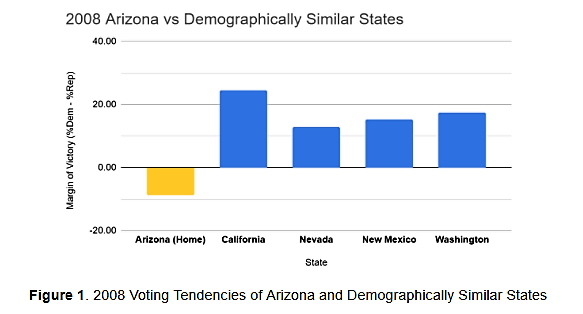
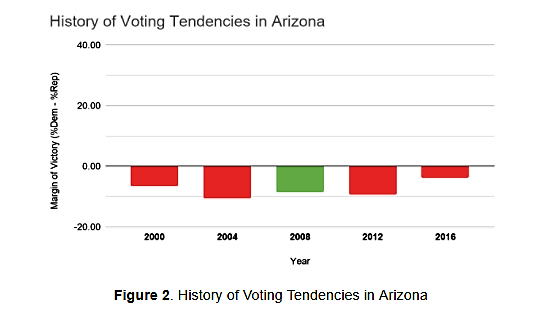
In contrast, Barack Obama’s home state of Illinois seemed to fall in line with demographically similar states (Figure 3), hinting that there might not have been a home state advantage. However, compared to the past and future presidential elections for the state, the MOV tells a different story (Figure 4). The model clearly shows that Illinois voters supported the Democratic party more in 2008 compared with previous and future presidential elections.This could be an indication that there may have been a home-state advantage for this term.
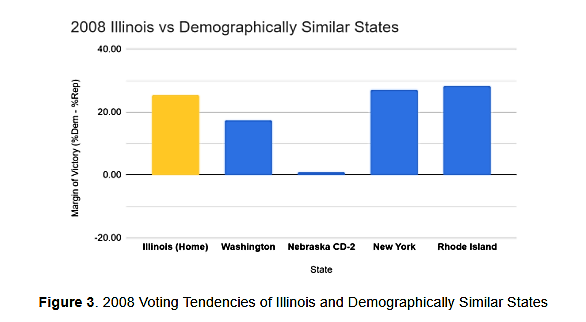
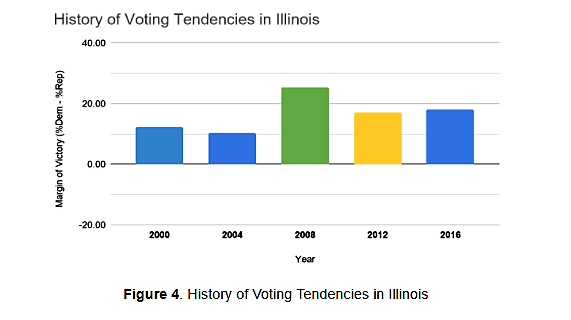
2012
Comparing the voting tendencies of Mitt Romney’s home state, Massachusetts, with demographically similar states during the 2012 election, there seems to be no advantage towards the Republican party. In fact, the MOV was more in favor of the Democratic party in Massachusetts than in any of the compared states (Figure 5). Looking at the electoral history in Massachusetts, there is little deviation from the voting tendencies (Figure 6), suggesting that no home state advantage was observed.
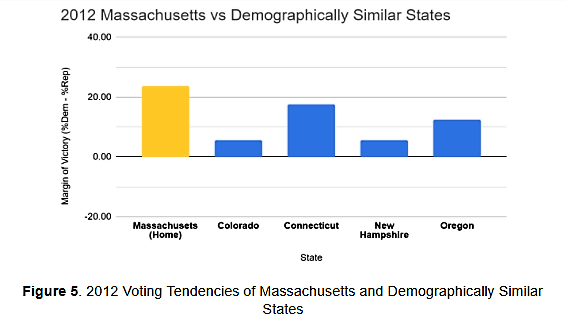
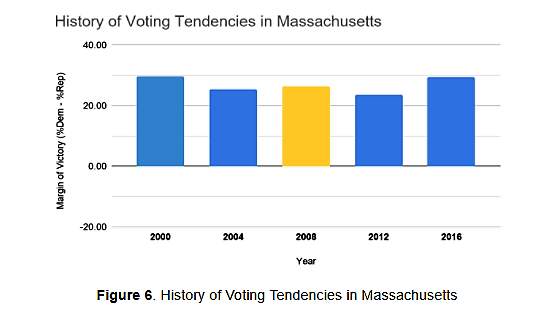
In 2012, President Obama ran as an incumbent in the general election. Comparing Illinois to demographically similar states, once again, the MOV in Illinois was fairly similar (Figure 7). Looking into the history of voting tendencies, there is actually a dip in MOV between 2008 and 2012 (Figure 4), possibly due to Obama being an incumbent. Nevertheless, neither graph suggests a home state advantage in Illinois.
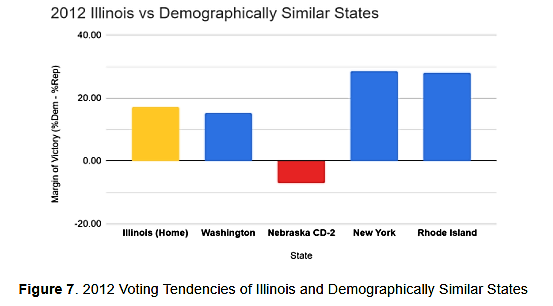
2016 COMPLICATIONS
The election of Donald Trump in 2016 posed a number of problems for our analysis. First, he shared a home state, New York, with Hillary Clinton, his opponent. This would seem to negate any effect either way. Additionally, unlike every other candidate we looked at, he had also never represented his home state, or even won an election there. It was simply where he lived. We expect that the home state advantage comes from the trust between the constituents and its representatives. This trust translates to increased support in the polls. Clinton had represented New York in the U.S. Senate from 2001 to 2009, up until she became Secretary of State for Barack Obama. The trust she built with the citizens of New York gave her the edge in an already blue state, which resulted in her winning the state.
2020 PREDICTIONS
The 2020 election is unlike any we’ve ever seen, and judging the impact of home state advantage is almost impossible. Based on our analysis of previous elections, it is unlikely that a home state advantage will significantly boost any candidate. In 2019, Trump changed his home state to Florida, a swing state with huge implications on the election. Based on Figure 8, it is clear how Florida has no clear voting tendencies, and Trump’s residency in Florida may possibly affect the final outcome.
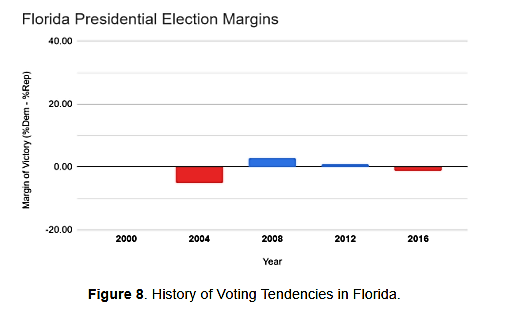
However, because of Trump’s limited political experience, we can’t credit any added support to Trump’s home state status in Florida. If he ends up winning Florida, it will most likely be due to other factors.
References
Linton, Caroline. “Lifelong New Yorker Trump Moving Primary Residence to Florida.” CBS News, CBS Interactive, 1 Nov. 2019, www.cbsnews.com/news/donald-trump-primary-residence-trump-moving-primary-residence-from-new-york-city-to-florida/.
“Margin-of-Victory (MOV).” Ballotpedia, ballotpedia.org/Margin-of-victory_(MOV).
“U.S. Census Bureau QuickFacts: United States.” Census Bureau QuickFacts, www.census.gov/quickfacts/fact/table/US/PST045219.
